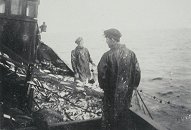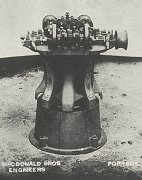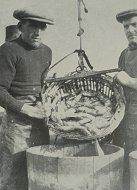Herring Home | Fishing for herring | Next
Hauling in the nets

At the end of the night, or when the fishermen detected that the nets were full, hauling began. Hemp nets were very heavy, especially when wet, and once full, it was a major task to haul them. At one time, fishermen had to haul the lines and nets onboard by hand. This was heavy and dangerous work and, if it was a good catch, could take several hours. The nets were hauled in using the warp or messenger rope, which took the direct strain off the nets. In the 1850s manual capstans were introduced. A capstan is a winch used for hauling lines onto a revolving drum. It took some of the hard work out of hauling the nets but it did not lift them out of the water. This still had to be done by hand.
Steam Capstan

In 1876, the steam capstan or 'iron man' as it was commonly known, was introduced onto fishing boats. A small steam-engine turned a large drum which could pull ropes on sails or nets with greater power than the 7 or 8 crew together. While some of the crew operated the capstan to wind in the warp, the other members of crew hauled in the nets. Once onboard, each net was shaken out so that the meshes were pulled open and the fish were released. The warp was then coiled away and the nets were carefully stowed on deck (and later, in the hold or net room). As well as being used to haul the nets, the steam-powered winch was also used to hoist the huge lugsails and sluice down the catch. The invention of the steam capstan meant that a larger number of nets and bigger sails could be used which in turn allowed larger boats to be introduced. These developments made bigger catches possible.

Once the fish were onboard, they were shovelled down into the hold (on the early open boats, the fish were just left in the base of the boat). As soon as the nets were hauled the boat made for port. It was important to get the fish to shore fresh, and the first fish often made the highest prices. More recently, once ice was introduced, fish could be preserved onboard for longer. Finally, the fish were removed from the boats in half cran baskets called swills. They were weighed before being taken to the curing yard or to be sold.